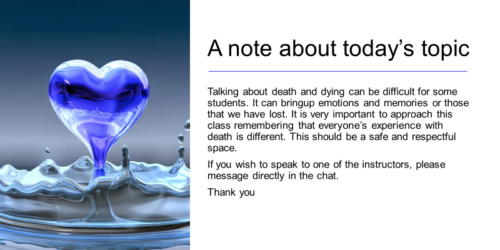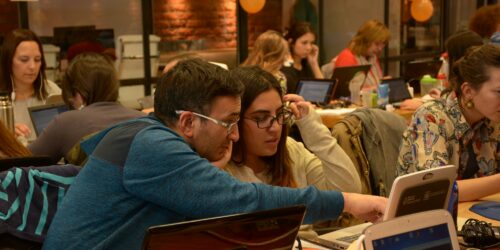
Children in the Classroom
By Sara Kafashan and Lauren Spring
Thinking about student parents
Some of you may have combined studying and parenting and you know how many challenges that can bring! Many of you may worry about what having an occasional infant or child in the classroom will do to the effective learning environment you aspire to create. We have all gotten used to seeing children pop into Zoom calls but we do not often see children on campus (aside from the daycare beside the Doon Main Building). Children are allowed on campus in certain situations. In this hub post, we will discuss what to do if a student asks to bring their child to class, or simply shows up with them. There will be two scenarios a) a breastfeeding parent, and b) a parent who unexpectedly had no childcare. It is best to be prepared for each.
Is there legislation on the topic?
Yes! The Ontario Human Rights (OHR) Code protects people from being discriminated against on 14 protected grounds, including such things as age, sex, ethnic origin, citizenship, disability, and family status. Two main areas under the protected grounds are related to children in the classroom:
- Protected ground of “sex”: A parent who is breastfeeding, chestfeeding, or bodyfeeding (please note that henceforth, these terms will be used interchangeably) infants or small children cannot be denied access to public spaces or services such as educational spaces. A parent cannot be asked to leave a space for chestfeeding and cannot be asked to “cover up” or “move to a more discreet location” (Ontario Human Rights Commission, n.d.).
- Protected ground of “family status”: The OHR code defines family status as “being in a parent and child [or child ‘type of’] relationship…that may not be based on blood or adoption ties, but that is based on care, responsibility and commitment” (Ontario Human Rights Commission, n.d.).
Due to this protected status, professors should follow this advice for navigating all requests related to accommodated areas: listen in good faith, collaborate to come up with a solution and check in to make sure the solution is working. Be ready to encounter a surprise and be your most caring self.
Breastfeeding infants and children
In most cases (except for lab classes or other campus spaces where safety is an issue, as outlined below) students are allowed to bring their breastfeeding infants and children to campus and class with them. The faculty can remind the student that they are welcome to breastfeed in class or anywhere on campus, and, if preferred, in the accommodation suite (if at Doon campus or on request at any campus). The World Health Organization recommends that, if the parent is able, young children be breastfed until at least 2 years old, so faculty may very well see both newborns and toddlers being breastfed on campus.
Faculty should note that the student and infant/child are allowed to stay in the lesson, so long as the infant/child is always supervised and does not disrupt the learning of others by continued noisemaking. Of course, an infant occasionally crying and fussing is not a disruption. It is okay if someone is uncomfortable – the child’s right to breastmilk supersedes other social discomfort.
If a student contacts a faculty member before the course starts or prior to a class meeting to ask if they can bring their infant or child to class, it is important to reply that breastfeeding children are always welcome and to please be sure that the classroom is not disrupted.
Requests to bring children who are not breastfeeding
The Ontario Human Rights Code protects the rights of parents and caregivers but has upheld the parent’s responsibility to find childcare as needed. If there is an extenuating circumstance, a one-off accommodation is possible.
Here are some general considerations :
- A student is allowed to bring a non-breastfeeding infant or child to campus, on an exceptional basis. An example of an exceptional basis might be if a parent had childcare arranged for their child, but the caregiver became sick or unavailable at the last minute and the student didn’t want to miss class on that day. But week to week, the expectation would be that parents have regular childcare in place so they can more effectively focus on their studies while in class.
- A student is never permitted to bring infants or children to a lab or shop due to safety concerns (even if the child is breastfeeding).
- A student may bring an infant or child to a classroom where safety is not a concern on an exceptional basis, so long as the following conditions are met:
- The infant/child must be supervised by the parent at all times;
- There must be enough physical space in the classroom to accommodate all students with the infant/child;
- The infant/child cannot disrupt the learning of other students.
If any of the above considerations are not met, faculty can ask the student and infant/child to leave, clearly explaining the issue at hand but doing so in a way that reduces embarrassment and a feeling of being excluded from the learning opportunity. For example, you could say, “I am so sorry. It looks like the child needs your full attention. Why don’t you go and enjoy some time with them and I will ask someone to take notes for you?”
When a student shows up with an infant or child to class without prior notice
If it is a classroom where safety is not a concern, faculty should allow this on a once-off basis while the parent seeks childcare. With this in mind, it is recommended that faculty discreetly check in with the student at some point. For example, during a break or prior to the lesson starting, so that the faculty can better understand the situation and discuss with the student what types of extra support they might need for that class (e.g. the faculty member might say: “ I see this is an unanticipated situation, do you think your child will be able to sit quietly for the next few hours? Would it help if I offered them some extra paper and pencils to draw beside you during class? If you feel they are becoming disruptive to others or need some space, feel free to take them for a walk in the hallway and to come back into class once they have settled; I can help you get caught up with any content you may miss while caring for them at the end of class today.”) You could also offer to ask other students to switch desks so the parent can be seated closer to the door if they need to take a break with their child.
What if a student says that they can’t find or afford childcare?
Bringing a non-breastfeeding child into class is still an exception and cannot become a regular practice. If the student is not satisfied with this response, you can encourage the student to speak to the Program Chair about other solutions.
What if a student asks to bring/brings an infant or child to an assessment or the testing center?
This is not permitted as the infant/child can contribute to disruptions to the assessment for other learners. Among other needs, the test centre serves students with disabilities that are particularly affected by distractions.
Summary
Please note that Student Advising, Accessibility & Testing is a great resource for faculty around this topic: email ssa@conestogac.on.ca. As well, if you have questions about best practices for students bringing infants/children into learning spaces, please contact your Chair.
References
National Institutes of Health (n.d.). Inclusive and Gender-Neutral Language. Retrieved on Mar 6th, 2024 from: https://www.nih.gov/nih-style-guide/inclusive-gender-neutral-language
Ontario Human Rights Commission. (n.d.). Pregnancy and Breastfeeding. Retrieved on March 6th, 2024 from: https://www.ohrc.on.ca/en/pregnancy-and-breastfeeding-brochure






